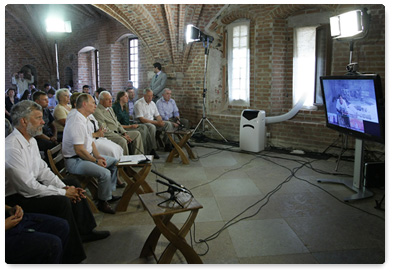Phanagoria
Phanagoria is Russia's largest archaeological site, located in the Temryuk district, on the Taman Peninsula. Works here are being carried out under the supervision of Dr. Vladimir Kuznetsov, who heads the Classical Archaeology Department of the Archaeology Institute, at the Russian Academy of Sciences.
The Kuznetsov-led expedition seeks to find out what Phanagoria may have looked like in the Archaic, Classical and Hellenic periods, as well as in the Roman era. One of its more specific objectives is to explore the part of the town that was inundated as a result of tectonic shifts. Regular submarine excavations done here since 1999 have brought to light some world-class artifacts, including inscribed marble panels.
The ongoing excavations in Taman are making it possible for scholars to reconstruct events that happened here more than 2,000 years ago (such as the revolt in Phanagoria against Mithridates VI Eupator, King of Pontus) and have until recently been known exclusively in interpretations offered by ancient historians.
Suzdal
A team of archaeologists is searching for the remnants of early Russian settlements near the town of Suzdal. They are led in their efforts by Nikolai Makarov, Director of the Russian Academy of Sciences' Archaeology Institute and a corresponding member of the Academy.
Geophysical surveying of seven settlements, which together occupy an area of more than 58 hectares, has been carried out in collaboration with experts from Germany. Advanced technology has made it possible -- for the first time in the history of the research of early Russian settlements -- to do geomagnetic surveys in so vast an area, spanning several mediaeval towns and their suburbs.
Particularly impressive are the breakthroughs made at the Shekshovo 2 and the Bolshoye Davydovskoye 2 sites, on the Urda River, which both were important centres in the northeast of the Suzdal region in the 10th -13th centuries.
The use of the geomagnetic method in archaeological surveying has opened up new opportunities for research, providing the expert community with new reference points for tracking and for focused exploration of isolated mediaeval structures as well as of densely built population centres. This has made excavations in the locality much more efficient.
Work is currently underway to dig the settlement of Shekshovo.
Ural Mountains
Researchers from Moscow University's Department of Archaeology are exploring cave monuments on the western slope of the Ural Mountains, in a woody area on the border between the Republic of Bashkortostan and the Chelyabinsk Region. The team is led by Vladislav Zhitenyov, a senior fellow at MU's History Department.
This season, the expedition is focusing on the world-famous Kapova Cave, alternatively known as Sulgan Tash, after the natural park on whose territory it is located.
The findings of tests to identify the composition of pigments employed in prehistoric rock paintings in the Urals are to be contrasted against pigments used in the Franco-Cantabrian region - an endeavour expected to provide a new perspective on the genetic ties between these two centres of Europe's Paleolithic cave art while also pinpointing commonalities in the use of caves from the Holocene eruptions through to the age of paleometals.
Fortress of Naryn-kala, outside Derbent, in the Republic of Dagestan
Derbent was founded in 438 by Persia's Sasanian dynasty, who in the 5th-6th centuries transformed the town into a stone fortress. It emerged on one of the key strategic spots of the Caspian Route, a passage of great commercial and military importance. Derbent's historical and architectural sites are outstanding examples of medieval fortification architecture, and feature on the UNESCO World Heritage List.
Archaeologists from the Dagestan Research Centre's Institute of History, Archaeology and Ethnography, of the Russian Academy of Sciences, have been doing on-site research in Derbent and its outskirts since 1970. From 1996 up to the present, their expedition has been led by Professor Murtazali Gajiyev, holder of a doctor's degree in history.
The expedition's most recent archaeological finds include 6th-century Persian cuneiform autographs by Derbent builders and the world's oldest official Muslim inscription, dating to AD 792 and making mention of Harun al-Rashid, the fifth caliph of the Abbasid dynasty.
The Gajiev-led team has also explored a 42-kilometre mountain wall that used to be part of the Derbent fortification compound, a medieval Zoroastrian cave burial complex, and a mediaeval Muslim monument known as Resurrection Gates, or Day of Judgment Gates.
In the current field season, the archaeologists are also working on low-lying cultural strata of the 9th-11th centuries and the pediment of a 6th-century fortification wall, among others.
Tartas 1, in Siberia
The monument is a burial site on the right-hand bank of the Tartas River, 5 kilometers south of the village of Vengerovo, in the Novosibirsk Region.
A team of researchers led by Vyacheslav Molodin, from the Archaeology and Ethnography Institute of the Russian Academy of Sciences' Siberian branch, has been exploring the site over the past eight years, using a multidisciplinary approach.
They are working in conjunction with counterparts from the Berlin-based German Archeological Institute, as part of an accord on cooperation in scientific research.
The site is of high scientific value as it contains traces of almost all of the Bronze Age archaeological civilizations known in the region to date (Ust-Tartas, Ogino, Krotovo, Andronovo, Irmen) from the 4th century B.C. through the beginning of the first millennium B.C. The objects found here include various artifacts (implements, weaponry, jewellery, and pottery made of bronze, rock and ivory), ample anthropological and osteological material, and fish fauna.
Work on this site provides clues for primary objectives of research, including the reconstruction of elements of the material and spiritual culture of southwestern Siberia's Bronze-Age populations, the identification of migration flows in the region and of mechanisms for interaction between native Mongoloid populations with Caucasoid re-settlers at the level of cultural and anthropological transformations, and the elaboration of models of genetic evolution at the level of the mitochondrial DNA of the entire gamut of Bronze-Age archaeological cultures in the south of the West Siberian Plateau. Research into the nuclear genome is forthcoming.




